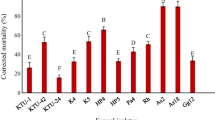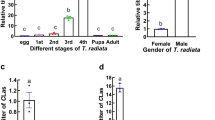Abstract
Tea is a perennial and evergreen plant. Cultivated tea trees provide a habitat for insect pests and their natural enemies. In Japan, granuloviruses (GVs) have successfully controlled two of the most important pests of tea, Adoxophyes honmai and Homona magnanima (Tortricidae: Lepidoptera). The GVs are produced in vivo and a single application sustains pesticidal efficacy throughout a year, which encompasses 4 to 5 discrete generations of both species. A. honmai and H. magnanima also have various natural enemies, especially hymenopteran parasitoids. Such resident natural enemies also play a role in reducing the pest density in virus-controlled fields, but the effect of virus infection on parasitoids sharing the same host larva has not been well studied. Survival of one of the major parasitoids of A. honmai, Ascogaster reticulata (Braconidae: Hymenoptera), is reduced by virus infection of the host. Viruses, including GV and entomopoxvirus (EPV), and certain koinobiont endoparasitoids, including A. reticulata, are both known to regulate host endocrinology. However, the GV and EPV have distinct host regulation mechanisms, and consequently have different impacts on the survival of A. retuculata, when A. reticulata parasitizes a host that is infected with either GV or EPV. These additional effects on host regulation displayed by both viruses and parasitoids affect the outcome of virus-parasitoid interactions.
Similar content being viewed by others
References
Abot A R, Moscardi F, Fuxa J R,et al. 1996. Development of resistance by Anticarsia gemmatalis from Brazil and the United States to a nuclear polyhedrosis virus under laboratory selection pressure. Biol Control, 7: 126–130.
Asser-Kaiser S, Fritsch E, Undorf-Spahn K,et al. 2007. Rapid emergence of baculovirus resistance in codling moth due to dominant, sex-linked inheritance. Science, 317: 1916–1918
Barbosa P. 1998. Conservation Biological Control. London: Academic Press p396.
Berling M, Blachere-Lopez C, Soubabere O,et al. 2009. Cydia pomonella granulovirus genotypes overcome virus resistance in the codling moth and improve virus efficiency by selection against resistant hosts. Appl Environ Microbiol, 275: 925–930.
Black B C, Brennan L A, Dierks P M,et al. 1997. Commercialization of Baculoviral Insecticides, In: Baculovirus (Miller L K,ed), New York: Plenum Press, p341–387.
Briese D T, Mende H A. 1983. Selection for increased resistance to a granulosis virus in the potato moth, Phthorimaea operculella (Zeller) (Lepidoptera: Gelechiidae). Bull Entomol Res, 73: 1–9.
Brooks W M. 1993. Host-parasitoid-pathogen interactions. In: Parasites and Pathogens of Insects (Beckage N E, Thompson S N, Federici B A, ed), San Diego: Academic Press, CA. p231–272.
Eberle K E, Asser-Kaiser S, Sayed S M, et al. 2008. Overcoming the resistance of codling moth against conventional Cydia pomonella granulovirus (CpGV-M) by a new isolate CpGV-I12. J Invertebr Pathol., 98: 293–298.
Edward J P, Weaver R J, Marris G C. 2001. Endocrine changes in lepidopteran larvae: potential challenges to parasitoid development and survival. In: Endocrine interactions of insect parasites and pathogens (Edwards J P; Weaver R J, ed), Oxford: BIOS Scientific Publishers Ltd. p1–32.
FAOSTAT, 2008. http://faostat.fao.org/
Huber J. 1998. Western Europe, In: Insect Viruses and Pest Management, (Hunter-Fujita, F R, Entwistle P F, Evans H F,et al. ed.), West Sussex: John Wiley & Sons, Inc., p201–215.
Ishii T, Takatsuka J, Nakai M,et al. 2002. A comparative study of the growth characteristics and competitive abilities of a nucleopolyhedrovirus and an entomopoxvirus in larvae of the smaller tea tortrix, Adoxophyes honmai (Lepidoptera: Tortricidae). Biol Control, 23: 96–105.
Kawai A. 1997. Prospect for integrated pest management in tea cultivation in Japan. JARQ, 31: 213–217.
Kirkpatrick B A, Washburn J O, Volkman L E. 1998. AcMNPV pathogenesis and developmental resistance in fifth instar Heliothis virescens. J Invertebr Pathol, 72: 63–72
Kodomari S. 1987. Control of leafrollers with granulosis viruses in tea field. 1. Effectiveness of application of GV mixture of oriental tea tortrix and smaller tea tortrix. Bull Shizuoka Tea Exp Stn, 13: 39–48.
Kodomari S. 1991. Pest and disease of tea and its control. Science of tea (Cha no kagaku): Asakura publishing Co., Ltd, p42–51. (in Japanese).
Kosugi Y. 1999. Decline in the susceptibility of smaller tea totrix, Adoxophyes honmai to some insecticides in Shimada city, Shizuoka Prefecture. Ann Rept Kanto Pl Prot Soc, 46: 123–126. (in Japanese).
Kouzaki Y. 1998. Current status and problems of control of tea leafrollers in Kagoshima using granulovirus. Sanshi konchu kenkyu shiryo, 23: 86–92. (in Japanese).
Landis D L, Swatten S D, Gurr G M. 2000. Habitat management to conserve natural enemies of arthropod pests in agriculture. Annu Rev Entomol, 45: 175–201.
Lawrence P O, Lanzrein B. 1993. Hormonal interactions between insect endoparaites and their host insects. In: Parasites and Pathogens of Insects (Beckage N E. Thompson S N. Federici B A, ed), San Diego: Academic Press, CA. p59–86.
Maeda-Yamamoto M, Ema K, Shibuichi I. 2007. In vitro and in vivo anti-allergic effects of ‘benifuuki’ green tea containing O-methylated catechin and ginger extract enhancement. Cytotechnology, 55: 135–142.
Minamikawa J, Osakabe M. 1979. Insect Pests of Tea Plant. Tokyo: Japan Plant Protection Association. p322. (in Japanese).
Nakai M, Takeda M, Kunimi Y. 1997. Seasonal changes in prevalence of viral disease and parasitism by parasitic insects in a larval population of the smaller tea tortrix, Adoxophyes sp. (Lepidoptera: Tortricidae) in a tea field. Appl Entomol Zool, 32: 609–615.
Nakai M, Shiotsuki T, Kunimi Y. 2004. An entomopoxvirus and a granulovirus use different mechanisms to prevent pupation of Adoxophyes honmai. Virus Research, 101: 185–191.
Nakai M, Shiotsuki T, Kunimi Y. 2005. An entomopoxvirus and a granulovirus have different impacts on Adoxophyes honmai (Tortricidae: Lepidoptera) simultaneously parasitized by Ascogaster reticulatus (Braconidae: Hymenptera). Biol Control, 33: 230–237.
Nakamura T. 2003. Control of leafrollers in tea fields using “Hamaki tenteki”. http://www.agrofrontier.com/guide/f_105. html
Nishi Y, Nonaka T. 1996. Biological control of the tea tortrix, using granulosis virus in the tea field. Agrochem Jpn, 69: 7–10.
Nonaka T, Onimaru T. 1988. Control of smaller tea tortirx, Adoxophyes sp. and tea tortrix, Homona magnanima DIAKONOFF by granulosis virus. 1. Decrease of virus susceptibility revealed in mass-production insects. Proc Assoc Pl Prot Kyushu, 34: 201–204. (in Japanese).
Okuno S, Nakai M, Hiraoka T,et al. 2002. Isolation of a protein lethal to the endoparasitoid Cotesia kariyai from entomopoxvirus-infected larvae of Mythimna separata. Insect Biochem Molec Biol, 32: 559–566.
O’Reilly D R, Miller L K. 1989. A baculovirus blocks insect molting by producing ecdysteroid UDP-glucosyl transferase. Science, 245: 1110–1112.
Ozaki S, Takeshima S. 1984. Decline in the susceptibility of Homona magnanima to methomyl and its chemical control in the middle part of Shizuoka Prefecture. Ann Rept Kanto Pl Prot Soc, 31: 171–172. (in Japanese).
Palli S R, Ladd T R, Tomkins W L,et al. 2000. Choristoneura fumiferana entomopoxvirus prevents metamorphosis and modulates juvenile hormone and ecdysteroid titers. Insect Biochem Mol Biol, 30: 869–876.
Shiga M, Yamada H, Oho N,et al. 1973. A granulosis virus, possible biological agent for control of Adoxophyes orana (Lepidotera: Tortricidae) in apple orchards. J Invertebr Pathol, 21: 149–157.
Shirai M, Kobayashi H, Ito H.et al. 1988. Decline in the susceptibility of Homona magnanima Diaknoff to methomyl in Shizuoka Prefecture. Ann Rept Kanto Pl Prot Soc, 35: 189–190. (in Japanese).
Tabata J, Noguchi H, Kainoh Y,et al. 2007. Sex pheromone production and perception in the mating disruption-resistant strain of the smaller tea leafroller moth, Adoxophyes honmai. Entomol Exp Appl, 122: 145–153.
Takagi K, 1974. Monitoring of hymenopterous parasite in tea field. Bull Nat Res Ins Tea, 10: 91–131. (In Japanese with English summary).
Takahashi M, Nakai M, Nakanishi K,et al. 2008. Genetic and biological comparisons of four nucleopolyhedrovirus isolates that are infectious to Adoxophyes honmai (Lepidoptera: Tortricidae). Biol Control, 46: 542–546.
Takeshima S, Kurebayashi, N. 1982. An increase in leafroller density in tea fields and a decline in the susceptibility to methomyl in Hatsukura, Shizuoka Prefecture. Ann Rept Kanto Pl Prot Soc, 29: 161. (in Japanese).
Teakle R E, Jensen J M, Giles J E. 1986. Age-related susceptibility of Heliothis punctiger to a commercial formulation of nuclear polyhedrosis virus. J Invertebr Pathol, 47: 82–92.
Uchidoi T, Mori Y, Asahina K. 1994. Decline in the susceptibility of oriental tea tortrix to benzoyl phenyl urea insecticides in Shizuoka Prefecture. Ann Rept Kanto Pl Prot Soc, 41: 261–263. (in Japanese).
Waage J. 1989. The population ecology of pest-pesticidenatural enemy interactions, In: Pesticides and non-target invertebrates (Jepson P C. ed), Wimporne, Dorset: Intercept Ltd, p81–93.
Weiss S, Vaughn J L. 1986. Cell culture methods for large-scale propagation of baculoviruses. In: The biology of baculoviruses: Practical application for insect control (Granados R R, Federici B A, ed), Vol 2, Boca Raton: CRC Press, Florida. p63–87.
Author information
Authors and Affiliations
Corresponding author
Additional information
Foundation item: This work was partially supported by Grantin-Aid for Scientific Research (B) (18380038).
Rights and permissions
About this article
Cite this article
Nakai, M. Biological control of tortricidae in tea fields in Japan using insect viruses and parasitoids. Virol. Sin. 24, 323–332 (2009). https://doi.org/10.1007/s12250-009-3057-9
Received:
Accepted:
Published:
Issue Date:
DOI: https://doi.org/10.1007/s12250-009-3057-9




